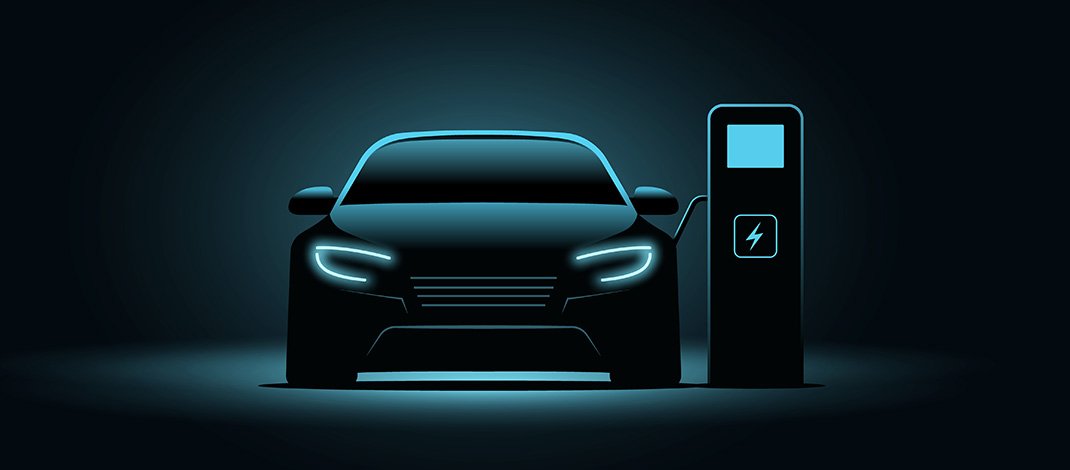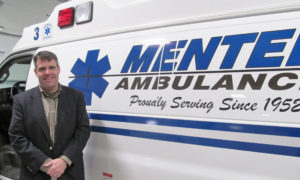Electric vehicles grow more common in CNY even as concerns about charging and range persist among consumers
By Ken Sturtz
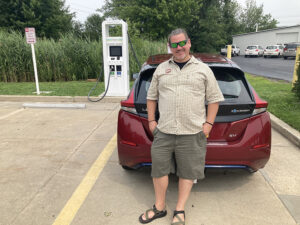
When Scott Thomas takes his Ford Mustang to car events around Central New York, he fields a lot of questions, but not the kind a car-lover would usually expect. No one quizzes him, for instance, about the horsepower or asks him to start and rev the engine.
“The first question people ask about is range and how I charge it,” he said.
Thomas, of Baldwinsville, owns a Mustang Mach-E Premium, Ford’s all electric version of the Mustang. With an extended range battery, he gets up to 300 miles on a charge, charging the vehicle in his garage overnight.
“This car is a real sweet car to drive,” he said. “It’s a very good cruising car, it’s great in traffic and it’s got top safety tech.”
While it might seem strange to marry an icon of American car culture with electric vehicle technology Thomas, who also owns a traditional gasoline powered Mustang, says he loves his Mach-E nonetheless. And he isn’t alone.
Electric vehicle (EV) ownership in New York state has skyrocketed from a few thousand EVs on the road a decade ago to just over 150,000 registered in June. That includes both all-electric cars and plug-in hybrids that run on electricity but also have gasoline engines to power the vehicle if the battery is drained. More than 100,000 EVs have hit the road in the state since 2021.
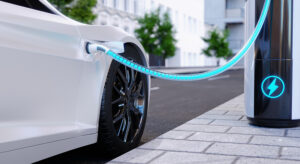 While EV ownership was initially concentrated in urban areas, that’s slowly changing. Onondaga and Oswego counties account for a fraction of the state’s total EVs — about 3,800 as of June — but like the rest of the state, most of them were purchased in just the last couple of years.
While EV ownership was initially concentrated in urban areas, that’s slowly changing. Onondaga and Oswego counties account for a fraction of the state’s total EVs — about 3,800 as of June — but like the rest of the state, most of them were purchased in just the last couple of years.
Experts say EVs are becoming more popular in places like Central New York for some of the same reasons EV ownership has grown in more populated areas.
The price of EVs has dropped to the point that they are increasingly within the budget of the average consumer and more competitive with traditional cars, said Eric Hittinger, an associate professor of public policy at the Rochester Institute of Technology.
“If you go back five or 10 years, electric vehicles were a very niche product for people who were willing to pay a huge amount of extra money for them,” he said. “It was really for people who wanted that product.”
That began to change a decade ago when Tesla introduced the Model S with the strategy of competing with other expensive high-end cars in the market such as BMW and Mercedes. Tesla bet that the additional cost of an EV would seem small to consumers who were already willing to pay $70,000-$100,000 for a vehicle. The Model S became the top-selling EV.
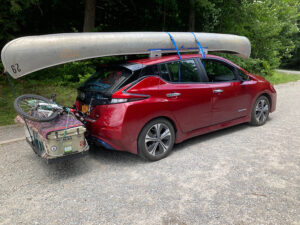 Traditional car makers such as the Big Three have taken EVs seriously and contributed to their price coming down and wider acceptance among consumers. And generous government subsidies have helped too.
Traditional car makers such as the Big Three have taken EVs seriously and contributed to their price coming down and wider acceptance among consumers. And generous government subsidies have helped too.
But while gas-powered vehicles come in every shape and color imaginable, the options for someone in the market for an EV remain fairly limited, Hittinger said, noting that roughly 90% of the EVs on the market today could be considered compact sedans or crossover SUVs.
“One of the obstacles that electric vehicles face is that if you want to buy a traditional gasoline vehicle you can choose from a huge number of designs,” he said. “If you want to buy an electric vehicle or if you’re considering an electric vehicle, you have to choose from the 20-50 options that are available.”
Car makers have begun to branch out, though they have remained focused on areas of the market where they can make the most money, Hittinger said. Ford has promoted its Mustang Mach-E and last year rolled out the Lightning, its first electric pickup truck. Both are highly profitable.
As the variety of EV options continues to grow — many families are awaiting the first all-electric minivan, for example — and the supply of batteries increases, EVs will likely creep more into the mass car market where the profit margins are smaller.
A tipping point will come when the sticker price for EVs, which are cheaper to operate than gas cars, dips below that of traditional vehicles.
“That’s the thing that will get people’s attention because we all love to save money,” Hittinger said. “If the cheapest thing on the sales floor is an electric car I think that’s going to suddenly move a lot of product.”
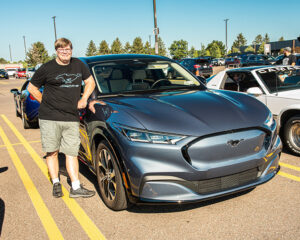
Thomas said his reasons for buying an EV included both wanting to reduce his carbon footprint and to save money.
A few years ago, he leased a Honda Clarity, a plug-in hybrid. Honda was offering a great deal, he said, so he signed a three-year lease to see if he liked having an EV.
Thomas lives in Baldwinsville and works as an IT manager at Clinton’s Ditch in Cicero and wanted to use the Clarity, which had a 50-mile battery range, for his 24-mile commute. When he did use the gasoline engine, Thomas said he got 42 miles to the gallon and only filled up his tank once every three or four months.
“I knew after about six months of owning it,” he said. “I said ‘Well heck I can live with a full EV,’ and I started researching.”
As he dove into researching EVs, Thomas discovered there weren’t a lot of options and very few EV models interested him. He considered Tesla but said that although he felt the company’s battery and in-car technology was excellent, its overall car quality wasn’t up to his standards.
Then, in 2019, Ford and Volkswagen announced they would be rolling out their new Mach-E and ID.4 respectively the following year. Both vehicles interested him and he ultimately decided to go with the Mach-E. He placed an order in October 2020, hoping it would be delivered before the lease on his Clarity was up in August 2021 but had no idea how long it would take Ford to ramp up production of the new EV.
His 2021 Ford Mach-E Premium was delivered in May 2021. It cost $54,000 and Thomas said the only option he got was the $5,000 extended range battery, which is rated for 300 miles on a full charge. He eventually received a $7,500 tax credit from the federal government.
Thomas said he charges his car overnight when demand on the electrical grid is lowest. The battery range varies depending on the weather and time of the year but he said he’s satisfied with his choice. He enjoys the car’s hands-free technology for interstate driving and cruise control with lane centering for local driving.
And he especially enjoys the savings. His electric bill increased about $40 a month but he doesn’t buy gas at all, which works out to a significant savings, he said. And he doesn’t have to worry about oil changes anymore.
Kieran O’Connor, of DeWitt, was also interested in purchasing an EV.
He needed to buy a new car and knew several people who owned EVs. But he was concerned about the higher cost of an EV versus a traditional car and didn’t want to deal with the challenge of having to stop on long trips to charge the battery.
“And I was like I’m not ready to commit,” he said. “But a plug-in hybrid I thought was a good option for me.”
O’Connor purchased a Toyota Prius plug-in hybrid in July 2021 for $32,000 and received a $4,500 federal tax credit and $500 state tax credit.
He said the car was surprisingly roomy for a compact — he is 6 feet tall and doesn’t feel cramped. But the best thing about owning a hybrid has been the savings. O’Connor is IT director for the East Syracuse-Minoa Central School District and drives five miles each way to and from work, so he can usually go the entire week using his car’s battery, which has a 30-mile range that dips to about 22 miles in winter.
O’Connor said he did the math and calculated that he averages 68 miles to the gallon with his car’s engine and spends 4.5 cents a mile for the electricity to power the batteries. He enjoys being able to commute mostly on electric but has the option of switching to gas if his battery runs low.
“I do think it’s a good little middle ground for people who don’t want to fully commit to a fully electric vehicle,” he said.
Christophe Colebrook, of Syracuse, wanted to buy an EV mostly because it’s environmentally friendly, but said the fact that it ended up saving him money was a happy coincidence.
Colebrook works in IT for AMP Urology and travels regularly for work, visiting offices around the region. He drove a Chevrolet Aveo and spent about $200 a month on his car, which was less than his travel reimbursements.
He wanted to buy an EV and use it as his work vehicle but knew the payments would be higher than his Aveo. So, he used a spreadsheet to calculate the cost, factoring in the price of electricity and the size of the battery.
“And the math worked out such that it would be affordable for me to make the switch,” he said. “I would pay less in fuel costs even though my car payment would be higher.”
Colebrook was driving the same roughly 5,000 miles a month but he went from spending $200 a month on fuel to $40 a month for electricity to power his car. The only problem was that the 2016 Nissan Leaf that he purchased had an 80-mile range. During the winter, for example, he struggled to make regular work trips to Fulton.
“So, to get to Fulton and back to Syracuse round trip in the winter with the heater on and the snow on the road and everything, it was challenging,” he said.
But there were charging stations along his route and he realized it was simple enough to plan his lunch breaks to stop at a restaurant in Clay with a free charging station. By the time he had eaten, his battery was charged enough to get back to Syracuse.
In 2018, Colebrook bought a newer Nissan Leaf with a longer range. Now he can make the 104-mile round trip drive from Syracuse to Utica without stopping to recharge his battery.
“That kind of range anxiety I had in the older model has really dissipated,” he said. “As the technology has gotten better, it’s made my life easier.”
Concerns about battery range and finding charging stations have been serious hurdles to greater EV adoption in rural areas of upstate New York, said Chris Carrick, energy program manager for the Central New York Regional Planning & Development Board.
“There’s still this issue of range anxiety as it’s called where folks who might think about buying an EV worry about being stranded as they’re out doing their daily business,” he said.
To a certain degree, it’s a perception issue, Carrick said, noting that EV owners do approximately 90%-95% of their charging at home. The issue has been helped by improvements in technology that have extended battery ranges and by consumers becoming more familiar with EVs, he said.
The number of charging stations has grown in recent years, especially for long distance travel. The state has focused on upgrading and adding fast charging stations at rest areas along the Thruway. And Tesla already has a nationwide fast-charging network in place.
Charging stations tend to be centered around denser population areas such as cities and highways, but Carrick said the Central New York Regional Planning & Development Board has worked with more than 20 municipalities in Central New York over the last two years to help them move forward with investments in charging stations, both in rural and urban areas.
In most cases, the charging stations have been Level 2 ports, which are meant to fully charge a vehicle in about five or six hours. Such destination charging works because most EV owners don’t need to fully charge their vehicle, but rather top it off while they spend a couple of hours somewhere, Carrick said.
Increasing the number of charging stations also has the side effect of increasing the visibility of EVs and helping to ease public perceptions about the technology.
“When folks see their neighbors or even their town or city investing in this technology, it gives them a little more confidence to try it for themselves,” Carrick said.

